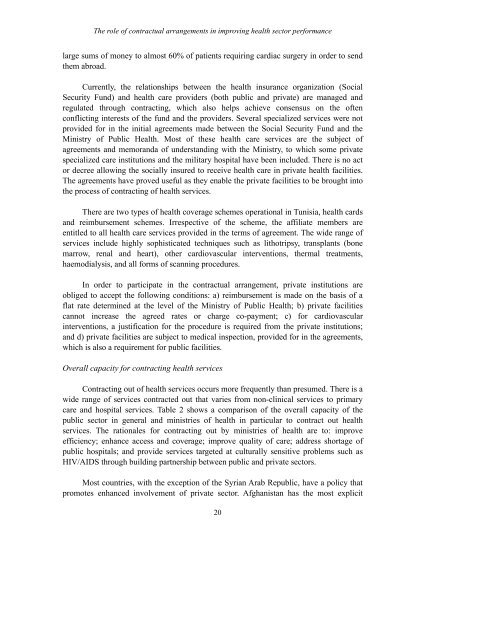The role of contractual arrangements in improving health sector ...
The role of contractual arrangements in improving health sector ...
The role of contractual arrangements in improving health sector ...
You also want an ePaper? Increase the reach of your titles
YUMPU automatically turns print PDFs into web optimized ePapers that Google loves.
<strong>The</strong> <strong>role</strong> <strong>of</strong> <strong>contractual</strong> <strong>arrangements</strong> <strong>in</strong> improv<strong>in</strong>g <strong>health</strong> <strong>sector</strong> performance<br />
large sums <strong>of</strong> money to almost 60% <strong>of</strong> patients requir<strong>in</strong>g cardiac surgery <strong>in</strong> order to send<br />
them abroad.<br />
Currently, the relationships between the <strong>health</strong> <strong>in</strong>surance organization (Social<br />
Security Fund) and <strong>health</strong> care providers (both public and private) are managed and<br />
regulated through contract<strong>in</strong>g, which also helps achieve consensus on the <strong>of</strong>ten<br />
conflict<strong>in</strong>g <strong>in</strong>terests <strong>of</strong> the fund and the providers. Several specialized services were not<br />
provided for <strong>in</strong> the <strong>in</strong>itial agreements made between the Social Security Fund and the<br />
M<strong>in</strong>istry <strong>of</strong> Public Health. Most <strong>of</strong> these <strong>health</strong> care services are the subject <strong>of</strong><br />
agreements and memoranda <strong>of</strong> understand<strong>in</strong>g with the M<strong>in</strong>istry, to which some private<br />
specialized care <strong>in</strong>stitutions and the military hospital have been <strong>in</strong>cluded. <strong>The</strong>re is no act<br />
or decree allow<strong>in</strong>g the socially <strong>in</strong>sured to receive <strong>health</strong> care <strong>in</strong> private <strong>health</strong> facilities.<br />
<strong>The</strong> agreements have proved useful as they enable the private facilities to be brought <strong>in</strong>to<br />
the process <strong>of</strong> contract<strong>in</strong>g <strong>of</strong> <strong>health</strong> services.<br />
<strong>The</strong>re are two types <strong>of</strong> <strong>health</strong> coverage schemes operational <strong>in</strong> Tunisia, <strong>health</strong> cards<br />
and reimbursement schemes. Irrespective <strong>of</strong> the scheme, the affiliate members are<br />
entitled to all <strong>health</strong> care services provided <strong>in</strong> the terms <strong>of</strong> agreement. <strong>The</strong> wide range <strong>of</strong><br />
services <strong>in</strong>clude highly sophisticated techniques such as lithotripsy, transplants (bone<br />
marrow, renal and heart), other cardiovascular <strong>in</strong>terventions, thermal treatments,<br />
haemodialysis, and all forms <strong>of</strong> scann<strong>in</strong>g procedures.<br />
In order to participate <strong>in</strong> the <strong>contractual</strong> arrangement, private <strong>in</strong>stitutions are<br />
obliged to accept the follow<strong>in</strong>g conditions: a) reimbursement is made on the basis <strong>of</strong> a<br />
flat rate determ<strong>in</strong>ed at the level <strong>of</strong> the M<strong>in</strong>istry <strong>of</strong> Public Health; b) private facilities<br />
cannot <strong>in</strong>crease the agreed rates or charge co-payment; c) for cardiovascular<br />
<strong>in</strong>terventions, a justification for the procedure is required from the private <strong>in</strong>stitutions;<br />
and d) private facilities are subject to medical <strong>in</strong>spection, provided for <strong>in</strong> the agreements,<br />
which is also a requirement for public facilities.<br />
Overall capacity for contract<strong>in</strong>g <strong>health</strong> services<br />
Contract<strong>in</strong>g out <strong>of</strong> <strong>health</strong> services occurs more frequently than presumed. <strong>The</strong>re is a<br />
wide range <strong>of</strong> services contracted out that varies from non-cl<strong>in</strong>ical services to primary<br />
care and hospital services. Table 2 shows a comparison <strong>of</strong> the overall capacity <strong>of</strong> the<br />
public <strong>sector</strong> <strong>in</strong> general and m<strong>in</strong>istries <strong>of</strong> <strong>health</strong> <strong>in</strong> particular to contract out <strong>health</strong><br />
services. <strong>The</strong> rationales for contract<strong>in</strong>g out by m<strong>in</strong>istries <strong>of</strong> <strong>health</strong> are to: improve<br />
efficiency; enhance access and coverage; improve quality <strong>of</strong> care; address shortage <strong>of</strong><br />
public hospitals; and provide services targeted at culturally sensitive problems such as<br />
HIV/AIDS through build<strong>in</strong>g partnership between public and private <strong>sector</strong>s.<br />
Most countries, with the exception <strong>of</strong> the Syrian Arab Republic, have a policy that<br />
promotes enhanced <strong>in</strong>volvement <strong>of</strong> private <strong>sector</strong>. Afghanistan has the most explicit<br />
20
















